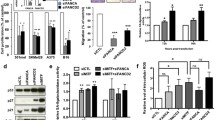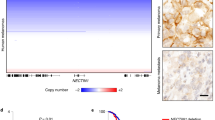Abstract
The NME1 gene represents the prototypical metastasis suppressor, whose expression inhibits cell motility and metastasis without impact on primary tumor growth in a number of different human cancers. This report outlines our recent efforts to define the molecular mechanisms through which NME1 both suppresses cell motility and promotes genomic integrity in the setting of human melanoma. Forced NME1 expression in a variety of melanoma-derived cell lines was shown to induce dynamic changes in cell morphology and reorganization of the actin cytoskeleton, with formation of a network of thick stress fibers and assembly of fibronectin fibrils at large focal adhesions. Moreover, NME1 expression results in adhesion reprogramming through an impact on integrin repertoire and focal adhesion dynamics. Having previously demonstrated that NME1 expression promotes repair of DNA damage induced by ultraviolet radiation (UVR) in both yeast and mammalian cells, probably via the nucleotide excision repair pathway, we have more recently demonstrated that NME1 is rapidly recruited to double-strand breaks. This preliminary result represents the first evidence of direct interactions between NME1 and DNA in the context of DNA repair and has set the stage for current efforts to probe its functional interactions with double-strand break repair pathways. Discussed herein are molecular models to explain the interactions of NME1 with such diverse cellular functions as cell motility and DNA repair, potentially through its nucleoside diphosphate kinase and 3′-5′ exonuclease activities.



Similar content being viewed by others
References
Agarwal RP, Robinson B, Parks RE (1978) Nucleoside diphosphokinase from erythrocytes. Methods Enzymol 51:376–386
Barkan D, Chambers AF (2011) beta1-integrin: a potential therapeutic target in the battle against cancer recurrence. Clin Cancer Res 17:7219–7223
Barkan D, Green JE, Chambers AF (2010) Extracellular matrix: a gatekeeper in the transition from dormancy to metastatic growth. Eur J Cancer 46:1181–1188
Berkovich E, Monnat RJ Jr, Kastan MB (2007) Roles of ATM and NBS1 in chromatin structure modulation and DNA double-strand break repair. Nat Cell Biol 9:683–690
Cervoni L, Pietrangeli P, Chichiarelli S, Altieri F, Egistelli L, Turano C, Lascu I, Giartosio A (2003) In vivo cross-linking of nm23/nucleoside diphosphate kinase to the PDGF-A gene promoter. Mol Biol Rep 30:33–40
Cervoni L, Egistelli L, Eufemi M, d'Abusco AS, Altieri F, Lascu I, Turano C, Giartosio A (2006) DNA sequences acting as binding sites for NM23/NDPK proteins in melanoma M14 cells. J Cell Biochem 98:421–428
Crawford RM, Treharne KJ, Arnaud-Dabernat S, Daniel JY, Foretz M, Viollet B, Mehta A (2006) Understanding the molecular basis of the interaction between NDPK-A and AMPK alpha 1. Mol Cell Biol 26:5921–5931
Danen EH, Ten Berge PJ, van Muijen GN, Hof-Grootenboer AE V’t, Brocker EB, Ruiter DJ (1994) Emergence of alpha 5 beta 1 fibronectin- and alpha v beta 3 vitronectin-receptor expression in melanocytic tumour progression. Histopathology 24:249–256
D'Souza-Schorey C, Chavrier P (2006) ARF proteins: roles in membrane traffic and beyond. Nat Rev Mol Cell Biol 7:347–358
Egistelli L, Chichiarelli S, Gaucci E, Eufemi M, Schinina ME, Giorgi A, Lascu I, Turano C, Giartosio A, Cervoni L (2009) IFI16 and NM23 bind to a common DNA fragment both in the P53 and the cMYC gene promoters. J Cell Biochem 106:666–672
Grzesiak JJ, Tran Cao HS, Burton DW, Kaushal S, Vargas F, Clopton P, Snyder CS, Deftos LJ, Hoffman RM, Bouvet M (2011) Knockdown of the beta(1) integrin subunit reduces primary tumor growth and inhibits pancreatic cancer metastasis. Int J Cancer 129:2905–2915
Hartsough MT, Steeg PS (2000) Nm23/nucleoside diphosphate kinase in human cancers. J Bioenerg Biomembr 32:301–308
Horak CE, Lee JH, Elkahloun AG, Boissan M, Dumont S, Maga TK, Arnaud-Dabernat S, Palmieri D, Stetler-Stevenson WG, Lacombe ML, Meltzer PS, Steeg PS (2007) Nm23-H1 suppresses tumor cell motility by down-regulating the lysophosphatidic acid receptor EDG2. Cancer Res 67:7238–7246
Huck L, Pontier SM, Zuo DM, Muller WJ (2010) beta1-integrin is dispensable for the induction of ErbB2 mammary tumors but plays a critical role in the metastatic phase of tumor progression. Proc Natl Acad Sci U S A 107:15559–15564
Jarrett SG, Novak M, Dabernat S, Daniel JY, Mellon I, Zhang Q, Harris N, Ciesielski MJ, Fenstermaker RA, Kovacic D, Slominski A, Kaetzel DM (2011) Metastasis suppressor NM23-H1 promotes repair of UV-induced DNA damage and suppresses UV-induced melanomagenesis. Cancer Res in press
Jarrett SG, Novak M, Harris N, Merlino G, Slominski A, Kaetzel DM (2013) NM23 deficiency promotes metastasis in a UV radiation-induced mouse model of human melanoma. Clin Exp Metastasis 30:25–36
Lazaro-Dieguez F, Colonna C, Cortegano M, Calvo M, Martinez SE, Egea G (2007) Variable actin dynamics requirement for the exit of different cargo from the trans-Golgi network. FEBS Lett 581:3875–3881
Leone A, Flatow U, King CR, Sandeen MA, Margulies IM, Liotta LA, Steeg PS (1991) Reduced tumor incidence, metastatic potential, and cytokine responsiveness of nm23-transfected melanoma cells. Cell JID - 0413066 65:25–35
Ma D, McCorkle JR, Kaetzel DM (2004) The metastasis suppressor NM23-H1 possesses 3′-5′ exonuclease activity. J Biol Chem 279:18073–18084
Ma D, Nutt CL, Shanehsaz P, Peng X, Louis DN, Kaetzel DM (2005) Autocrine PDGF-dependent gene expression in glioblastoma cells is mediated largely by activation of the transcription factor SRE-BP, and is associated with altered genotype and patient survival in human brain tumors. Cancer Res 65:5523–5534
Marino N, Marshall JC, Steeg PS (2011) Protein-protein interactions: a mechanism regulating the anti-metastatic properties of Nm23-H1. Naunyn Schmiedebergs Arch Pharmacol 384:351–362
Morgan MR, Hamidi H, Bass MD, Warwood S, Ballestrem C, Humphries MJ (2013) Syndecan-4 phosphorylation is a control point for integrin recycling. Dev Cell 24:472–485
Nikkola J, Vihinen P, Vlaykova T, Hahka-Kemppinen M, Heino J, Pyrhonen S (2004) Integrin chains beta1 and alphav as prognostic factors in human metastatic melanoma. Melanoma Res 14:29–37
O'Connor KL, Chen M, Towers LN (2012) Integrin alpha6beta4 cooperates with LPA signaling to stimulate Rac through AKAP-Lbc-mediated RhoA activation. Am J Physiol Cell Physiol 302:C605–C614
Oshita F, Kameda Y, Hamanaka N, Saito H, Yamada K, Noda K, Mitsuda A (2004) High expression of integrin beta1 and p53 is a greater poor prognostic factor than clinical stage in small-cell lung cancer. Am J Clin Oncol 27:215–219
Postel EH, Berberich SJ, Flint SJ, Ferrone CA (1993) Human c-myc transcription factor PuF identified as nm23-H2 nucleoside diphosphate kinase, a candidate suppressor of tumor metastasis. Science 261:478–480
Purdue MP, Freeman LE, Anderson WF, Tucker MA (2008) Recent trends in incidence of cutaneous melanoma among US Caucasian young adults. J Investig Dermatol 128:2905–2908
Salerno M, Ouatas T, Palmieri D, Steeg PS (2003) Inhibition of signal transduction by the nm23 metastasis suppressor: possible mechanisms. Clin Exp Metastasis 20:3–10
Shevelev IV, Hübscher U (2002) The 3′-5′ exonucleases. Nat Rev Mol Cell Biol 3:1–12
Shibue T, Weinberg RA (2009) Integrin beta1-focal adhesion kinase signaling directs the proliferation of metastatic cancer cells disseminated in the lungs. Proc Natl Acad Sci U S A 106:10290–10295
Veluthakal R, Kaetzel D, Kowluru A (2013) Nm23-H1 regulates glucose-stimulated insulin secretion in pancreatic beta-cells via Arf6-Rac1 signaling axis. Cell Physiol Biochem 32:533–541
Volk T, Geiger B, Raz A (1984) Motility and adhesive properties of high- and low-metastatic murine neoplastic cells. Cancer Res 44:811–824
Wagner PD, Steeg PS, Vu ND (1997) Two-component kinase-like activity of nm23 correlates with its motility-suppressing activity. Proc Natl Acad Sci U S A 94:9000–9005
Winnepenninckx V, Lazar V, Michiels S, Dessen P, Stas M, Alonso SR, Avril MF, Ortiz Romero PL, Robert T, Balacescu O, Eggermont AM, Lenoir G, Sarasin A, Tursz T, van den Oord JJ, Spatz A (2006) Gene expression profiling of primary cutaneous melanoma and clinical outcome. J Natl Cancer Inst 98:472–482
Yang M, Jarrett SG, Craven R, Kaetzel DM (2009) YNK1, the yeast homolog of human metastasis suppressor NM23, is required for repair of UV radiation- and etoposide-induced DNA damage. Mutat Res 660:74–78
Yao ES, Zhang H, Chen YY, Lee B, Chew K, Moore D, Park C (2007) Increased beta1 integrin is associated with decreased survival in invasive breast cancer. Cancer Res 67:659–664
Zhang Q, McCorkle JR, Novak M, Yang M, Kaetzel DM (2011) Metastasis suppressor function of NM23-H1 requires its 3′;-5′ exonuclease activity. Int J Cancer 128:40–50
Acknowledgments
This work was supported by the United States National Institutes of Health, National Cancer Institute grants CA83237 and CA159871 (D.M. Kaetzel), and training grant T32CA15474 (M.K. Leonard).
Author information
Authors and Affiliations
Corresponding author
Rights and permissions
About this article
Cite this article
Kaetzel, D.M., Leonard, M.K., Cook, G.S. et al. Dual functions of NME1 in suppression of cell motility and enhancement of genomic stability in melanoma. Naunyn-Schmiedeberg's Arch Pharmacol 388, 199–206 (2015). https://doi.org/10.1007/s00210-014-1010-4
Received:
Accepted:
Published:
Issue Date:
DOI: https://doi.org/10.1007/s00210-014-1010-4




